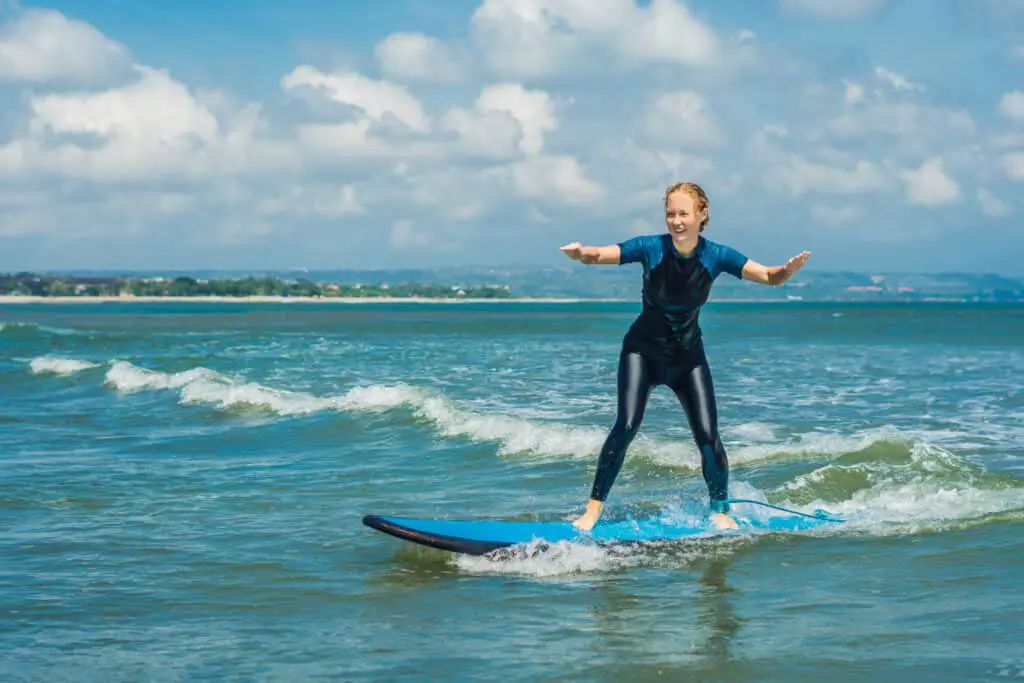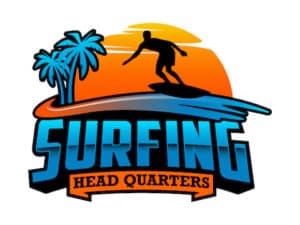
The minimum surfable wave height for an average-sized person is around 0.5 ft (ankle height). Due to the lack of power in the wave, a surfer needs a highly buoyant surfboard such as a longboard or foam board to keep the forward momentum.
For beginner surfers, surfing in small waves provides a safe and pleasant experience.
Let’s look into surfing small waves in more detail regarding equipment requirements and learn how to measure the size of the wave and terminology.
In this article, you will learn about:
- Minimum wave height for surfing
- What is the best surfboard for small waves?
- How to read the surf report
- Terminology
- How is wave height measured?
Dive in!
What is the Minimum Wave Height for Surfing?
The minimum surfable wave with a surfboard is around 0.5ft or ankle-high. This means when you stand up after catching a wave, the lip of the waves is on the ankle line of the surfer.
Anything smaller than this, there won’t be enough push for a surfer to catch the wave and stay on top of the water when riding. However, for a very lightweight surfer, like a child, you may be able to ride very small waves. You might have seen a dad pushing a child on a surfboard on a hardly formed wave.

Therefore, the minimum surfable wave height is somewhat dependent on the surfer.
For individual surfers, the minimum wave height is determined by the size of the board and skill level. If you have a longer/ more buoyant surfboard, you can paddle faster, get on to the wave easily, and ride without losing speed despite the lack of assistance from a wave.
However, if a beginner surfer rides a small shortboard on smaller days, you won’t get much assistance from the wave to propel you forward, and it will sink unless you have the skill to keep the speed going.
What Types of Board to Ride in Smaller Waves?
Minimal Board
A minimal board is a shrunken-down longboard shape whose length ranges from 7’0″ to 8’6″ feet. The nose of a minimal board is chunky, allowing for effortless paddling and a decent ability to catch waves.
This board is perfect for beginners as its unique shape provides added volume and buoyancy to catch small waves.
Foam Board
Foam boards, also known as foamie or soft top boards, are among the most user-friendly. These are made with lightweight and buoyant foam material. The average length of a beginner foam board is over 8 feet. These boards usually come with three fins on the back for easy maneuverability.
If you are a beginner considering surfing practice, foam boards are a great option. The good thing about these boards is that they have cushioning on the surface, which keeps you safe when the board bumps into you. They are also quite affordable. Read here before buying a foam board as a first board: I have covered the topic in detail.
Longboard
The longboard is the most traditional surfboard and is ideal for small waves. These boards come in lengths ranging from 9 to 9″6 feet (although there are even longer ones).
There are various shapes of longboards, which are generally divided into nose riders and performance longboards.
Noseriders tend to be thicker, wider and often longer (9’3″+) than performance longboards for their stability while noseriding. Performance longboards are generally around 9’0″ – 9’2″ in length and are designed for maneuverability on the wave. However, performance longboards still offer the great noseriding capability.
Surfers prefer longboards over short boards for smaller waves because the longboards’ extra length offers greater flotation, streamlined speed and stability. Longboard surfers can catch waves much earlier than shortboard because of their paddling speed and floatation; this is great when the line-up is crowded.
Short small wave boards
All major surfboard manufacturers sell small wave surfboards: high-volume short boards. You can think of this board type as a short, wide and thick surfboard.
With the shorter lengths, the surfboards fit nicely inside the wave’s pocket and allow tighter turns. To compensate for the lack of length, these board types come with a wider width and increased thickness to optimise the volume.
You should keep in mind that these boards are designed for more skilled surfers, and for beginner surfers, it’s easier to ride minimal or longboard because of the board’s volume and length. A longer board provides more glide through the water, making the board travel faster with the same amount of paddling.
Look how 11 world title champion Kelly Slater rides a short small wave board. Notice how he can maintain the speed even in very small waves size.
Once you have a suitable surfboard, it’s time to find the optimal conditions for surfing and read the surf report.
How to Read a Surf Report
New surfers often struggle to make sense of the information provided in a surf report. Different elements, such as the kind of break (sand or reef), swell type, etc., all contribute to what is considered an ‘ideal wave’ for surfing. Here, we’ll break down the fundamentals so you can understand and estimate the surfing condition before heading out.
Swell Size
Measured in either feet or meters, the swell size gives us a magnitude of the wave’s height. For a beginner, a good time to go surfing is when the forecast calls for waves of 1-2 ft in height. If you are just starting, go for a wave size smaller than 3 foot. See below for the detail.
Swell Direction
This indicates the swell’s bearing in degrees. The direction from which the wave will emerge can help you predict where to find the best waves. For example, a beach will be less affected by waves coming from the south if it faces northeast.
Wind Direction
Surfing conditions are ideal when there is no wind or offshore wind, which creates glassy conditions (when the water’s surface is smooth), and the absence of wind gusts makes for ideal surfing conditions. This determinant can be divided into two types:
- Offshore wind: These winds push waves away from the land and are ideal for most surfing.
- Onshore wind: These winds blow from the ocean to land, creating choppy surfing conditions. However, onshore winds are ideal for practising aerial maneuvers as the wind pushes the board back towards the surfer’s feet, helping to keep the board under their feet.
Wind Speed
A lower number indicates a better chance of a good wave. You should be looking for speeds does not exceed 20 km/hr. If too strong, even offshore wind will make surfing difficult: the wind pushes the surfer away from shore, making it difficult to take off, and it creates sprays of water as the wave breaks, blocking the vision.
Parts of a Wave
| Peak | This is the highest point of a wave. When paddling, always go towards the peak |
| Trough | Just before a wave crests, it sinks to its lowest point, the trough. It can be seen below the horizon |
| Face | The steep part facing the breaking area is called the face |
| Whitewater | The frothy & foamy section that has previously crashed is called whitewater |
| Tube | Also known as a barrel, this is a hollow area inside the breaking wave. It can commonly be seen in larger, powerful waves. |
| Lip | This is the highest point of a wave before it turns over |
| Shoulder | This angled and unbroken part of the wave next to the peak provides riding surfaces. |
Bonus: Here is one of the best surf forecast websites.
How are the wave heights are measured?

No, you are not alone. It’s confusing. People use different wave height measurements worldwide, and there are no standardised methods. In general, there are two main ways to measure wave height:
Measuring the height using a human scale
This is done by measuring a wave height when a 6-foot person stands at the bottom of the wave and sees how tall the face of the wave is.
So, if the lip of the wave is at shoulder height, we call it shoulder-high surf. If it’s slightly bigger than a person, it’s called overhead; if the wave’s face is 12 feet (twice the size of the person), it’s called double-overhead.
While this can be quite subjective, it does provide some consistency.
Measuring the wave in feet.
This method is widely used in Australia and Hawaii, which creates a lot of confusion. It measures the height of the back of the wave.
The Australian wave size measurement below will be paired to the human scale so you can get a rough idea.
Hawaiian scales tend to underestimate the size of the waves, so beware!
| Wave height in feet (Australian) | Distance from base to lip of wave on front of wave |
| 0.5 ft. | Ankle-high |
| 1 ft. | Knee to waist high |
| 2 ft. | Waist to shoulder high |
| 3 ft. | Head high |
| 4 ft. | Overhead high |
| 5 ft. | Between overhead and double overhead high |
| 6 ft. | Double overhead |
| 7 ft. | No one uses this number. Don’t ask why. |
| 8 ft. | Double and a half overhead high |
| 10 ft | Triple overhead |
| 20-30 ft. | Big. Only big-wave surfers call how big the numbers are. Some say it measures in fear. |

